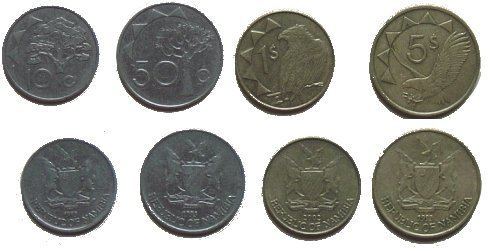Code NAD Symbol N$ | ||
 | ||
Banknotes $10, $20, $50, $100, $200 Coins 5, 10, 50 cents, $1, $5, $10 User(s) Namibia (alongside South African rand) | ||
The Namibian dollar (symbol: $; code: NAD) has been the currency of Namibia since 1993. It is normally abbreviated with the dollar sign $, or alternatively N$ to distinguish it from other dollar-denominated currencies. It is divided into 100 cents.
Contents
History
The dollar replaced the South African rand, which had been the country's currency while it was under South African rule as South-West Africa from 1920 until 1990. The rand is still legal tender, as the Namibian dollar is linked to the South African rand and can be exchanged on a one-to-one basis locally. Namibia was also part of the Common Monetary Area from independence in 1990 until the introduction of the dollar in 1993.
In 1990, moves were under way to replace the rand with a new Namibian currency. The name kalahar was proposed, as the Kalahari Desert is located in eastern Namibia. The name of Namibia's central bank was going to be known as the Namibia Reserve Bank. Denominations of this planned currency included 2, 5, 10, and 20 kalahar. (Note: There were two different designs for the 20 kalahar specimen notes.) These plans came to nothing, but some specimen notes were printed in a range of denominations.
The Bank of Namibia issued the first banknotes on 15 September 1993 and, in December, issued the first national coins.
Coins
Coins in circulation
Years of mintage are 1993, 1996, 1998, 2000, 2002, 2008, 2009 and 2010. The cent coins are made of nickel plated steel and the dollar coins of brass
Dollar or mark?
During the planning phase of the introduction of a new national currency replacing the South African rand, the newly founded Bank of Namibia minted a proof series of coins denominated in dollars as well as in marks, for the consideration of the Namibian Ministry of Finance. The decision then fell in favour of the name ‘dollar’ for the new currency.
The proof series consisted of four different coins: 1 mark, 1 dollar (both in copper/nickel), 10 marks and 10 dollars (both in silver). The obverse of the mark pieces shows a sitting lion where the dollar pieces depict a San (Bushman) with bow and arrow. All obverse sides bear the indication of denomination as well as the remark ‘PROBE’/‘ESSAI’ (proof). The reverse of the 1-mark/1-dollar pieces shows Namibia’s former coat of arms surrounded by the inscription ‘NAMIBIA’, the year (1990) and two ears of corn. The ten-mark/ten-dollar pieces bear the inscription ‘INDEPENDENCE’/‘UNABHÄNGIGKEIT’ (German: ‘independence’) instead of the ears.
There was a series of Namibian pattern coins denominated in South African Rand dated 1990. This short-lived tender was cited in the 2005 edition of Krause's 'Unusual World Coins'.
